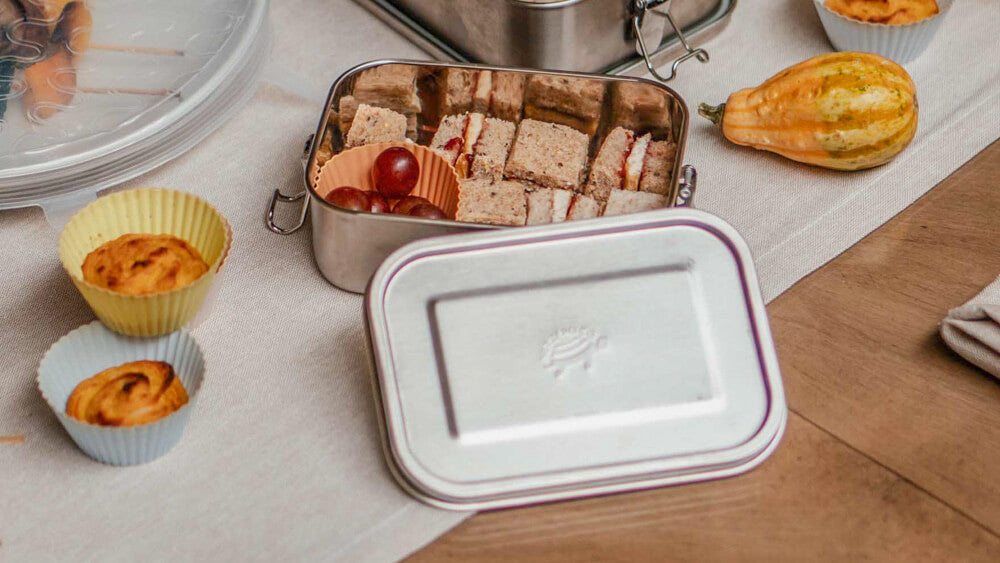
Phthalates: The Endocrine Disruptors You Need To Avoid & Best Alternatives
Written by Konstantina Antoniadou.
Plastic food packaging, vinyl flooring, fluid bags, cosmetics, nail polish — what’s the not-so-secret, “everywhere chemical” in our most used household and cosmetic products?
Phthalates!
You may have heard the term “Phthalates-free” a gazillion times before. Heck, it’s even on our list of banned ingredients. But what is so harmful about these chemicals? Doctors, zero-waste aficionados, and activists alike are practically begging consumers to minimize their exposure to phthalates as much as possible — and for a pretty good reason.
Phthalates: the carcinogenic chemicals in plastic
Phthalates are a group of chemicals used to make plastics more durable. From eating and drinking food that has previously come in contact with items containing Phthalates (aka plastic food packaging), to breathing phthalate particles in the air, these carcinogenic chemicals always manage to find a way into our lives. So let’s take a closer look at the origins, benefits, and negatives of these oh-too-familiar synthetic chemicals.
The origin of Phthalates
First introduced in the Roaring Twenties, Phthalates quickly became the new “it” chemicals that could easily replace all other substances that made plastic more durable and flexible. Almost a decade later, in 1931, the commercial availability of PVC, along with the development of di-2-ethylhexyl phthalate (DEHP), became the catalysts of the growth of the phthalate industry. It didn’t take long for these man-made chemical compounds to practically take over the world.
Why Phthalates are so popular
Thanks to their numerous benefits, Phthalates were widely used in a large number of consumer goods and building materials. Until recently, manufacturers used hundreds of millions of pounds of phthalates each year in products, including children's toys. In fact, Phthalates are a common ingredient of PVC food packaging items, such as the lining of food containers — yes, even though they are proven to be endocrine disruptors!

The benefits of Phthalates
Even though the carcinogenic properties of Phthalates are well known, these chemicals, unfortunately, have many benefits, which is exactly why they became so popular in the first place. Some of the many benefits of using high phthalates include low-temperature performance, flexibility, heat resistance, and electrical resistivity. They perform well in changing weather conditions and are UV resistant, as well as flexible adhesives and sealants.
Why are phthalates SO dangerous?
Imagine a baby lying on his favorite play mat, gazing through the window at the sun. He enthusiastically picks up his teething rings and happily chews directly on them. Chemicals, classed in Europe as “endocrine disruptors”, break down in his saliva and, consequently, enter his body. Now consider this; every time you place a delicious sandwich in a plastic sandwich bag that’s not clearly labeled as Phthalates-free, you run the risk of contaminating your food which you then eagerly eat — because it’s so delish. Exposure to Phthalates, even through inhalation, may trigger asthma, allergy, or other autoimmune disorders.

Unfortunately, these chemicals carry a slew of carcinogenic properties and can even cause diseases, including cardiovascular, liver, urologic, endocrine, and genital diseases. Classified as endocrine-disrupting chemicals (EDCs), phthalates interfere with thyroid and sex hormone production.
Another recent study on expectant mothers and phthalate exposure suggested the suspected links to “preterm birth, preeclampsia, maternal glucose disorders, infant cryptorchidism, infant hypospadias, and shorter anogenital distance in newborns.” On top of that, both high and low phthalates have also been linked to lower IQs in infants. Now, if you take into consideration that Declining testosterone levels in all populations have also been linked to elevated phthalate exposure, it doesn’t take long to realize that, even though useful, these chemicals do more harm than good.
How to prevent exposure to Phthalates
Great, we are all widely aware of the carcinogenic chemicals in plastic, what’s next? The good news is that You can minimize your exposure to phthalates significantly by staying away from some specific items.

Research shows that our bodies can quickly adapt to any changes in the use of toxins like phthalates. So, by reducing the use of personal care products, and household items with Phthalates, you can help your body lower its chemical levels in just a few days!
Find healthy alternatives
Make sure to avoid plastic wrap and plastic food containers made from PVC. Also, it would be best to avoid reheating food or beverages in plastic containers completely, as the toxins can leach into the food easily at high temperatures. Instead, opt for glass or stainless-steel food containers like this travel-friendly stainless steel bento box.
Pack your leftovers in non-toxic air-tight silicone stretch lids, and choose Reusable Food Storage Bags made of silicone to keep your snacks with you at all times. Yes, they are also perfectly suitable for the microwave and freezer.
Exposure to Phthalates happens in numerous ways, including personal care products. Swap your regular deo with a safe, Zero Waste Natural Deodorant and add a Zero Waste Solid Hair Bar & conditioner to your bathtime routine. Unlike regular shampoos, these bars are completely natural and toxic-free all and replace two plastic bottles!
A few additional ways to minimize your exposure to phthalates:
- Choose fragrance-free body care
- Avoid scented candles, laundry detergents, and cleaning products that list “fragrance” — these laundry detergent strips will do the trick
- Stay away from synthetic air fresheners
- Instead of plastic teethers, bath toys, playmats, and all things synthetic choose toys and items made of natural rubber, wood, silicone, and organic fibers
- Choose phthalate-free condoms made from natural latex rubber and natural lubricant to replace your regular synthetic latex condoms
Yes, Phthalates are carcinogenic contaminants you need to avoid BUT..
While phthalates are indeed something we should all do our best to avoid, becoming paranoid over the exposure we cannot control can only negatively impact our lives. What we can do is monitor the items that find their way into our household and do our best to opt for healthy alternatives that are not only toxic-free but also friendly to our Earth.
In 2022, there are so many fantastic chemical-free products that can replace pretty much every questionable item in our household and beauty arsenal —from cleaning and self-care to food storage. So Let's propel the low-waste lifestyle with easy-to-make changes that will benefit us and the world around us.




































